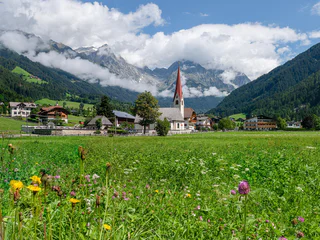
1/3
Parish church Saint Walburg - Antholz Niedertal
Anterselva di Sotto/Antholz-Niedertal, Rasen-Antholz/Rasun Anterselva, Dolomites Region Kronplatz/Plan de Corones
Voel de spirituele kracht van deze plaatsen, bewonder de Romaanse architectuur en gotische fresco's of ontsnap gewoon even aan het leven van alledag. Ontdek de bijzonderheden van de vele kerken, kapellen en kloosters uit verschillende tijdperken en stijlen.

1/3
Anterselva di Sotto/Antholz-Niedertal, Rasen-Antholz/Rasun Anterselva, Dolomites Region Kronplatz/Plan de Corones

1/2
Collepietra/Steinegg, Karneid/Cornedo all'Isarco, Dolomites Region Eggental

1/3
Villabassa/Niederdorf, Niederdorf/Villabassa, Dolomites Region 3 Zinnen

1/4
Sesto/Sexten, Sexten/Sesto, Dolomites Region 3 Zinnen

1/5
Fiè/Völs, Völs am Schlern/Fiè allo Sciliar, Dolomites Region Seiser Alm

1/4
Brunico città/Bruneck Stadt, Bruneck/Brunico, Dolomites Region Kronplatz/Plan de Corones

1/3
Nova Ponente Centro/Deutschnofen Dorf, Deutschnofen/Nova Ponente, Dolomites Region Eggental

Anterselva di Sopra/Antholz-Obertal, Rasen-Antholz/Rasun Anterselva, Dolomites Region Kronplatz/Plan de Corones

1/4
Campolino/Lothen, St.Lorenzen/San Lorenzo di Sebato, Dolomites Region Kronplatz/Plan de Corones

1/2
Tires/Tiers, Tiers am Rosengarten/Tires al Catinaccio, Dolomites Region Seiser Alm

Dobbiaco Nuova/Neutoblach, Toblach/Dobbiaco, Dolomites Region 3 Zinnen

Taisten/Tesido, Welsberg-Taisten/Monguelfo-Tesido

1/5
Siusi/Seis, Kastelruth/Castelrotto, Dolomites Region Seiser Alm

Innichen/S. Candido, Innichen/San Candido, Dolomites Region 3 Zinnen

1/4
Castelrotto/Kastelruth, Kastelruth/Castelrotto, Dolomites Region Seiser Alm

1/2
Alpe di Siusi/Seiseralm, Kastelruth/Castelrotto, Dolomites Region Seiser Alm

1/2
Brunico città/Bruneck Stadt, Bruneck/Brunico, Dolomites Region Kronplatz/Plan de Corones

1/4
S. Maddalena/St. Magdalena - Funes/Villnöss, Villnöss/Funes, Dolomites Region Villnösstal

Rasun di Sopra/Oberrasen, Rasen-Antholz/Rasun Anterselva, Dolomites Region Kronplatz/Plan de Corones

1/2
Castelrotto/Kastelruth, Kastelruth/Castelrotto, Dolomites Region Seiser Alm

1/4
Siusi/Seis, Kastelruth/Castelrotto, Dolomites Region Seiser Alm

Nove Case/Neunhäusern, Rasen-Antholz/Rasun Anterselva, Dolomites Region Kronplatz/Plan de Corones

1/4
Sesto/Sexten, Sexten/Sesto, Dolomites Region 3 Zinnen

Fiè/Völs, Völs am Schlern/Fiè allo Sciliar, Dolomites Region Seiser Alm

1/4
S.Cristina Gherdëina/S.Cristina Val Gardena/S.Cristina Gherdëina/St.Christina in Gröden, S.Crestina Gherdëina/Santa Cristina Val Gardana, Dolomites Region Val Gardena

Rasun di Sotto/Niederrasen, Rasen-Antholz/Rasun Anterselva, Dolomites Region Kronplatz/Plan de Corones

Roncadizza/Runggaditsch - Ortisei/St.Ulrich, Urtijëi/Ortisei, Dolomites Region Val Gardena

1/3
Badia/Badia, Badia, Dolomites Region Alta Badia

1/4
Siusi/Seis, Kastelruth/Castelrotto, Dolomites Region Seiser Alm

Albion/Albions, Lajen/Laion